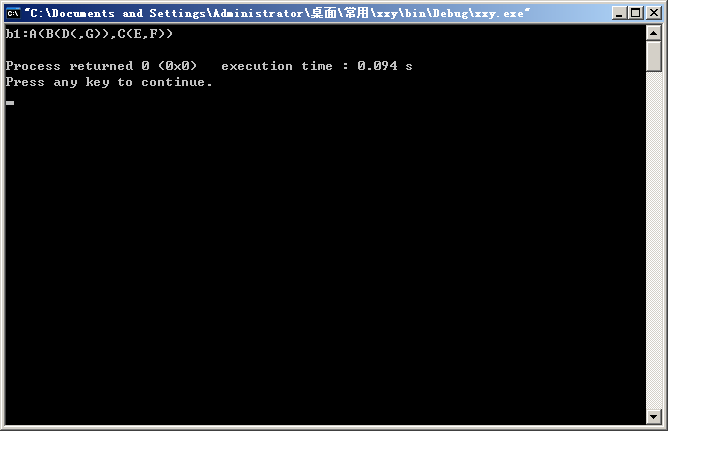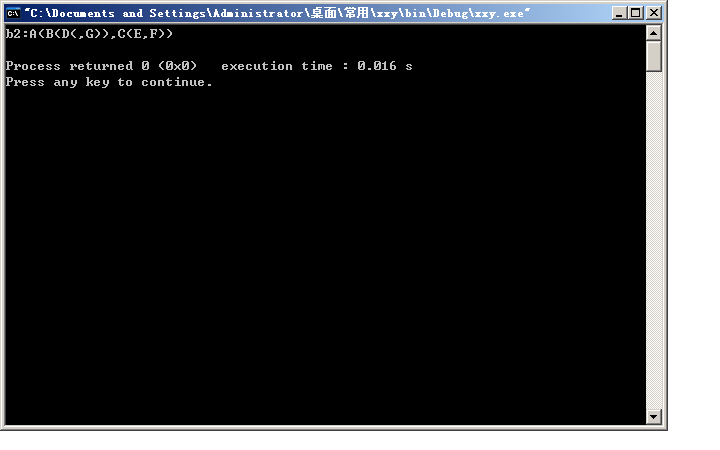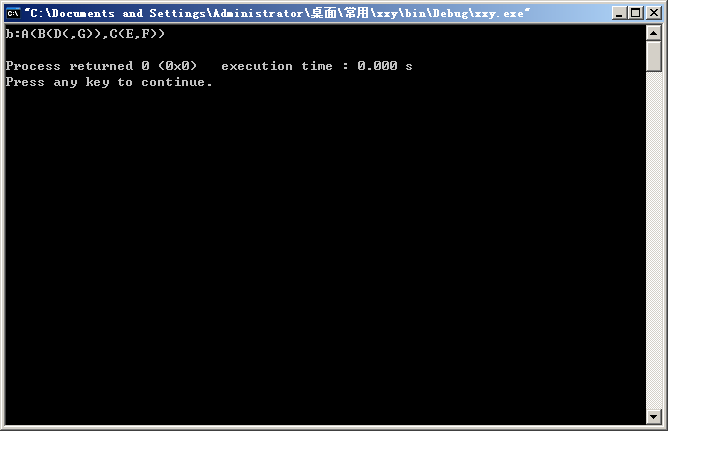问题及代码:
/*
* Copyright(c) 2017,烟台大学计算机学院
* All rights reserved.
* 文件名称:xxy.
* 作 者:徐潇雨
* 完成日期:2017 年 11 月 2 日
* 版 本 号:v1.0
*
* 问题描述:
* 输入描述:
* 程序输出:
*/
(1)1.由先序序列和中序序列构造二叉树
#include <stdio.h>
#include <malloc.h>
#include "btree.h"
/*BTNode *CreateBT1(char *pre,char *in,int n)
pre存放先序序列,in存放中序序列,n为二叉树结点个数,
本算法执行后返回构造的二叉链的根结点指针*/
{
BTNode *s;
char *p;
int k;
if (n<=0) return NULL;
s=(BTNode *)malloc(sizeof(BTNode)); //创建二叉树结点*s
s->data=*pre;
for (p=in; p<in+n; p++) //在中序序列中找等于*ppos的位置k
if (*p==*pre) //pre指向根结点
break; //在in中找到后退出循环
k=p-in; //确定根结点在in中的位置
s->lchild=CreateBT1(pre+1,in,k); //递归构造左子树
s->rchild=CreateBT1(pre+k+1,p+1,n-k-1); //递归构造右子树
return s;
}
int main()
{
ElemType pre[]="ABDGCEF",in[]="DGBAECF";
BTNode *b1;
b1=CreateBT1(pre,in,7);
printf("b1:");
DispBTNode(b1);
printf("\n");
return 0;
}
(2)由后序序列和中序序列构造二叉树
#include <stdio.h>
#include <malloc.h>
#include "btree.h"
BTNode *CreateBT2(char *post,char *in,int n)
/*post存放后序序列,in存放中序序列,n为二叉树结点个数,
本算法执行后返回构造的二叉链的根结点指针*/
{
BTNode *s;
char r,*p;
int k;
if (n<=0) return NULL;
r=*(post+n-1); //根结点值
s=(BTNode *)malloc(sizeof(BTNode)); //创建二叉树结点*s
s->data=r;
for (p=in; p<in+n; p++) //在in中查找根结点
if (*p==r)
break;
k=p-in; //k为根结点在in中的下标
s->lchild=CreateBT2(post,in,k); //递归构造左子树
s->rchild=CreateBT2(post+k,p+1,n-k-1); //递归构造右子树
return s;
}
int main()
{
ElemType in[]="DGBAECF",post[]="GDBEFCA";
BTNode *b2;
b2=CreateBT2(post,in,7);
printf("b2:");
DispBTNode(b2);
printf("\n");
return 0;
}
(3)由顺序存储结构转为二叉链存储结构
#include <stdio.h>
#include <malloc.h>
#include "btree.h"
#define N 30
typedef ElemType SqBTree[N];
BTNode *trans(SqBTree a,int i)
{
BTNode *b;
if (i>N)
return(NULL);
if (a[i]=='#')
return(NULL); //当节点不存在时返回NULL
b=(BTNode *)malloc(sizeof(BTNode)); //创建根节点
b->data=a[i];
b->lchild=trans(a,2*i); //递归创建左子树
b->rchild=trans(a,2*i+1); //递归创建右子树
return(b); //返回根节点
}
int main()
{
BTNode *b;
ElemType s[]="0ABCD#EF#G####################";
b=trans(s,1);
printf("b:");
DispBTNode(b);
printf("\n");
return 0;
}
























 316
316

 被折叠的 条评论
为什么被折叠?
被折叠的 条评论
为什么被折叠?








